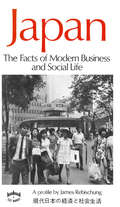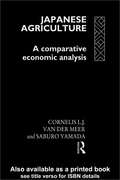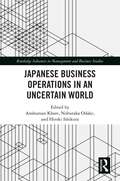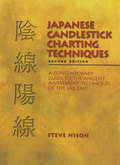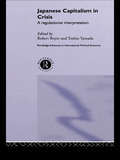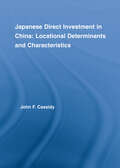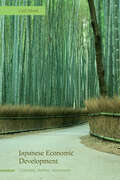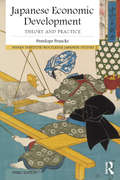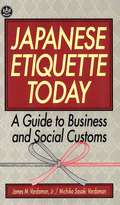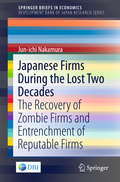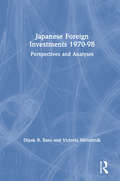- Table View
- List View
Japan: The Facts of Modern Business and Social Life
by James RebischungJames Rebischung's intention is to report as objectively as possible on the current Japanese scene and to provide a more balanced view of Japan that is usually given in travel folders, official publications, magazine reports, and art books. <P><P>To believe, as many people do, that Japan is either a tourist wonderland or a country where businessmen plot unfair competitive practices while bathing with geisha on company expense accounts, or that it is a rich land leaping forward to an economic paradise is to be both foolish and wrong. The Japanese people have a stirring history full of the richness of human life, and they have an interesting and exciting future. But they are in the transitional present as it is lived now, and that is what this book is all about.
Japan: The Miracle Years
by Louis T. Wells Jr.Japan experienced rapid growth in the 1950s and 1960s while following a set of policies that differ from current policies in fashion. Although some observers believe that Japanese growth occurred in spite of the policies rather than because of them, several countries have looked to Japan's approach during this period as a way to accelerate their own growth. This case provides data on performance and describes the important institutions, policies, and control tools that were used in Japan. A rewritten version of two earlier cases.
Japanese Agriculture: A Comparative Economic Analysis
by Cornelius van der Meer Saburo YamadaFood prices in Japan are extremely high by international standards, and its agricultural sector is beset by low productivity. This book determines what the real level of Japanese agricultural productivity is by comparing it with other developed countries and with less developed countries. Japan has set itself the goal of catching up with the European Community in agricultural productivity, and so the book makes an extended comparison of Japanese and Dutch agriculture to try and determine the likelihood of this happening. Extended inter-country comparisons with Taiwan and the United States are also undertaken. The book analyses how various political and economic factors have interacted to prevent Japan achieving high agricultural productivity at the same time as it was experiencing remarkable growth in its industrial productivity. Solutions to the current problem are suggested and the book concludes by discussing the relevance of Japan's experience to other developing economies.
Japanese Business Operations in an Uncertain World (Routledge Advances in Management and Business Studies)
by Anshuman KhareThis book looks at Japanese companies in manufacturing and services sectors and how they are trying to emerge from the prolonged uncertainty of the pandemic. The chapters are written by those dealing with Japanese business under the shadow of the pandemic and being influenced by the continuous and rapid adoption of digital technologies in business and our daily lives. This book brings together the experiences of big and small corporations while looking at how digital transformation and the pandemic combined have led to a transformation in the product, production processes and services. It highlights the role played by robots, 3-D printing and renewable energy in manufacturing while the impact can be seen in the changes coming to future offices, how we work and interact and how we relax through tourism and travel on the service side. The services sector is as much impacted by digital transformation and the pandemic as any other field in business. Aimed at academics, researchers and practitioners, Japanese Business Operations in an Uncertain World will provide valuable insights into how Japanese organizations are adapting to the dual impact of the pandemic and advancements in digital technologies.
Japanese Candlestick Charting: A Contemporary Guide to the Ancient Techniques of the Far East
by Steve NisonA form of technical analysis, Japanese candlestick charts are a versatile tool that can be fused with any other technical tool, and will help improve any technician's market analysis. They can be used for speculation and hedging, for futures, equities or anywhere technical analysis is applied. Seasoned technicians will discover how joining Japanese candlesticks with other technical tools can create a powerful synergy of techniques; amateurs will find out how effective candlestick charts are as a stand-alone charting method. In easy-to-understand language, this title delivers to the reader the author's years of study, research and practical experience in this increasingly popular and dynamic approach to market analysis. The comprehensive coverage includes everything from the basics, with hundreds of examples showing how candlestick charting techniques can be used in almost any market.
Japanese Capitalism in Crisis: A Regulationist Interpretation (Routledge Advances In International Political Economy Ser.)
by Toshio Yamada Robert BoyerThe contributors to Japanese Capitalism in Crisis show that there can be a middle ground between the current extremes of the Japanese economy, and offer two proposals: a deeper understanding of long term development, and an extension of existing theory.
Japanese Contractors in Overseas Markets: Bridging Cultural and Communication Gaps (Management in the Built Environment)
by Kazuhito Suzuki Low Sui PhengThis book explores the differences in cultural attributes and management factors to enable managers working for Japanese contractors to reduce misunderstandings and misinterpretations when communicating with project team members from different cultural backgrounds. It focuses on Japanese contractors operating in Singapore, since the Singapore construction industry has, for many years, been one of the largest overseas construction markets for the top-5 Japanese contractors. Using Hofstede’s national cultural framework for the cultural studies in construction project management, it reveals various real-world management practices and discusses national cultural differences relating to managers working for Japanese contractors in Singapore as well as the communication weaknesses of current management practices and styles. The results presented provide useful lessons for Japanese contractors operating in Singapore, as well as other parts of the world, to bridge cultural and communication gaps.
Japanese Cooperation and Supporting Industry in Mexico’s Automotive Sector: USMCA, Covid-19 Disruptions, and Electric Vehicle Production (New Frontiers in Regional Science: Asian Perspectives #72)
by Leo Guzman-AnayaThis pioneering work focuses on the crucial role that the cooperation of Japan, a major stakeholder in production networks in North America, is playing in supporting Mexico's domestic suppliers of the automotive industry. The importance of Japanese cooperation is analyzed with an examination of the transfer of knowledge and technology crucial for reshaping the automotive industry. Additionally, particular interest is given to the challenges posed to Mexico's automotive industry by the United States–Mexico–Canada Agreement (USMCA), the Covid-19 disruptions, and the transition to electric vehicle (EV) manufacturing. The book demonstrates the importance of cooperation in economic partnership agreements such as the one between Japan and Mexico to strengthen the role of investment in complex regional integration networks and to face new challenges. Academics and policymakers will find a framework to guide research and decision-making regarding the transformation of automotive manufacturing and production networks in Mexico's automotive industry. Specifically, the new conditions facing small and medium-sized enterprises (SMEs) and the important part that Japanese cooperation will play in the industry's evolution.
Japanese Corporate Transition in Time and Space
by Tomoko KuriharaThis book is an ethnography of a Japanese white-collar workplace in Osaka carried out during the late 1990s. It explores the relevance of social models to the analysis of social relations and women's status in the workplace by examining concepts of time, ritual, and space via the theory of practice.
Japanese Digital Cultural Promotion: Online Experience of Kyoto (Routledge Contemporary Japan Series)
by Nadejda GadjevaGadjeva uses Kyoto as a case study to explore the innovative mechanisms being used to promote Japanese culture and cultural properties since the outbreak of COVID-19. Beginning by setting out the main initiatives and actors involved in preserving, introducing and utilising Kyoto’s cultural heritage, Gadjeva proceeds to discuss alternative approaches using digital technologies. These tools include remote access immersive reality, virtual reality, augmented reality, augmented virtuality, and mixed reality. She looks at how such approaches have been applied to Kyoto’s digital museums, real-time online experiences, and other virtual projects presenting tangible, intangible, and folk heritage. In doing so she draws on a wide range of interviews with experts from the Japan Foundation, the Kyoto Art Center, and other related institutions to investigate the limitations and possible strategies for further development of these practices. She also interviews scholars, government officials and experts from Europe about the prospects for further remote online experiences, applied both specifically to Kyoto and more broadly to cultural tourism. Based on the findings, the book discusses particular future challenges and suggests specific policies and project proposals for further remote online experiences of Kyoto’s cultural properties. A valuable read for professionals and scholars of cultural and tourism studies, that will be of particular interest to those specialising in Japan.
Japanese Direct Investment in China: Locational Determinants and Characteristics
by John F. CassidyChina, with the world's largest population, is set to become the second largest market in the world by 2010. The importance of understanding the environment for foreign direct investment (FDI) in China has never been more apparent. With this as a context, this book examines FDI in China with the emphasis on the 'where to locate' question. Japanese direct investment is used as a case study elucidating the key locational determinants and characteristics thereof. This is the first book focusing on the 'where to locate' question with respect to the China market. All companies with a China strategy and all university business departments will find this book of vital importance.
Japanese Direct Investment in Mexico's Transport Equipment Sector: Macro Impact and Local Responses (New Frontiers in Regional Science: Asian Perspectives #22)
by Melba Falck-Reyes Leo Guzman-AnayaThis book introduces an interdisciplinary approach to the study of Japanese foreign direct investment determinants, the close relations between foreign investment and trade flows in the host country, and the effects and responses by the local economy. It provides an accessible and comprehensive view of the overall macro impacts and local effects associated with the increasing flow of Japanese firms to Mexico’s automotive industry. The research and its outcomes presented here follow extensive fieldwork and use unique statistical datasets to integrate qualitative and quantitative approaches to the analysis. Carefully chosen case studies produce an integrated approach to the subject. As a result, the book fills a vacuum on this topic and provides readers with a clear understanding of the complex interactions among participating actors: Japanese multinationals and Japanese parts-and-components suppliers, Mexican local suppliers, government at the national and local levels, and cooperating Japanese agencies. By critically assessing current theories and empirical methodologies the monograph covers aspects related to the creation of regional production networks and their impact on trade patterns of the recipient country, location determinants of Japanese foreign investment, and spillover externalities in host entities. It presents the reader with a comprehensive view of the different levels of interaction between multinational firms, local recipient economies, and local suppliers and the challenges they face to engage in global chains of production. The book is highly recommended to academics and their students who seek to understand the complex international economic relations in the global economy. This compilation also serves as a valuable guide to policy makers, both at national and local levels, as it provides an informed analysis of how to engage local suppliers in regional and global production chains.
Japanese Discourses on the Marxian Theory of Finance (Marx, Engels, and Marxisms)
by Kei EharaThis edited volume traces the development of the Marxian theory of finance in Japan. Japanese Marxists have long been engaged in this field of study, yet their achievements are hardly known in other languages. Japanese Discourses on the Marxian Theory of Finance brings together in English for the first time six core essays essential to the understanding of the history and development of Japanese Marxian economics. Part I considers the so-called Uno-Miyake debate, which shaped the direction of the research in postwar Japan. Part II includes the three core essays influenced by Uno, including an essay by Shigekatsu Yamaguchi, who introduced a new method to systematically deal with “credit creation” which must be duly taken into consideration if scholars are to analyze today’s “financialization." Finally, the last two essays follow from Yamaguchi’s influential theory to consider the relation of banking with the capital market to complete the theory of finance in Marxian economics.
Japanese Economic Development: Markets, Norms, Structures
by Carl MoskThis book presents three distinct approaches to understanding how and why Japan made the transition from a relatively low-income country mainly focused on agriculture to a high-income nation centered on manufacturing and services. Making a case forover determination in economic behaviour, the authors argue that individual, firm level and governmental behavior is simultaneously determined by the interaction of markets, norms and structures and that change over time is rarely if ever limited to the economy operating in isolation from social norms and structures.
Japanese Economic Development: Theory and practice (Nissan Institute/Routledge Japanese Studies)
by Penny FrancksThis fully revised and updated third edition of Japanese Economic Development looks at Japan's economic history from the nineteenth century through to World War II, recasting analysis of Japan’s economic past in the light fresh theoretical perspectives in the study of economic history and development. Francks draws out the historical roots of the institutions and practices on which Japan's post-war economic miracle was based and provides a comparative framework within which the Japanese case can be understood and related to development in the rest of the world. New features for this edition include: textboxes summarising key concepts expanded coverage of the early-modern economy, the ‘traditional sector’, and the international context of Japanese growth an increased number of case studies fully up-dated references, glossary and bibliography. Taking a thematic approach, this textbook demonstrates how studying the first example of Asian industrialisation can provide the basis for an alternative, non-western narrative of development. As it such is an important resource for undergraduate and postgraduate courses on the Japanese economy, as well as comparative economic development and economic history more generally.
Japanese Economics and Economists since 1945 (Routledge Studies in the Growth Economies of Asia #Vol. 26)
by Aiko IkeoIn this book, leading Japanese scholars present an objective study of Japanese economics since 1945, based on statistical data and analysis.The first half of the book assesses the impact and influence of Japanese economics within the international academy, demonstrating the increasingly important contribution of Japanese approaches to theoretical and mathematical economics. Part Two investigates the impact of Japanese economics on policy-making, dissecting the formulation of the famous 'industrial structure policy', and comparing Japanese economics with American and Korean models.Presenting a wealth of original empirical data, and a new perspective on international economic theory, this book will be of interest to historians, theoreticians and policy-makers alike.
Japanese Education since 1945: A Documentary Study
by Edward R. Beauchamp James M. Vardaman JrA study of postwar education in Japan which is intended to shed light on the development of Japanese educational policy. Major educational documents are included, some taken from records of the American occupation forces and others being original translations from Japanese sources.
Japanese Equities: A Practical Guide to Investing in the Nikkei
by Michiro NaitoAn indispensable resource for anyone wishing to understand and successfully invest in the Nikkei. Recent years have seen steady growth in investor interest in the Japanese equity market, the second largest in the world. Japanese Equities describes how the Nikkei works, explains its driving factors and presents a collection of insightful case studies to help you successfully invest in the market. Author Michiro Naito, a former equity derivatives/quantitative strategist for J.P. Morgan Securities Japan, helps you understand the ups and downs of the market and capitalise on its money-making opportunities. Already a substantial part of many equity investor portfolios, the Nikkei exhibits characteristics that respond more sensitively to global economic conditions than other developed markets. This valuable book helps you grasp the idiosyncrasies of the market and correctly time investing decisions to maximise profits. This English translation of the original Japanese book includes additional chapters discussing recent political developments that influence the Japanese economy such as the re-election of Prime Minister Shinzo Abe, the trade policies of Donald Trump (the US-China trade war) and the difference in monetary policy between the Bank of Japan and the FED. This book: Offers a simple quantitative strategy to take advantage of the cyclical trends and repeating patterns of the Nikkei to attain desirable returns Explains how derivatives instruments affect the equity market, which is seldom covered in textbooks Highlights a quantitative approach supported by solid historical back-tests Discusses fundamental and technical factors that underlie the movement of the Japanese equity market Provides insights drawn from the author’s decades-long research and experience working in the securities industry Japanese Equities: A Practical Guide to Investing in the Nikkei is a must-have text for investors, hedge fund and pension fund managers, academics, researchers and students of international finance.
Japanese Etiquette Today
by Michiko Sasaki Vardaman James M. VardamanJapan today "looks" more and more Western, principles governing social and business relations become harder to see. Most foreigners know that Japanese etiquette differs from that of other countries, but few people know the extent of the differences. It is this diversity that first attracted the authors of Japanese Etiquette Today, a book written to make working and living in Japan enjoyable and rewarding experiences.The authors look at a variety of formal and informal occasions governed by subtle rules-visiting a Japanese office and h ome, giving and returning gifts, attending weddings and funerals, and much more. The result is an informal overview of Japanese society and a manual of practical advice on getting a long in that society. Complete with essential vocabulary and phrases, this handy guidebook explains what to do and perhaps more important what not to do, what to say, what to wear, indeed, whatever you need to observe the complex rules of modern Japanese etiquette.
Japanese Etiquette Today
by Michiko Sasaki Vardaman James M. VardamanJapan today "looks" more and more Western, principles governing social and business relations become harder to see. Most foreigners know that Japanese etiquette differs from that of other countries, but few people know the extent of the differences. It is this diversity that first attracted the authors of Japanese Etiquette Today, a book written to make working and living in Japan enjoyable and rewarding experiences.The authors look at a variety of formal and informal occasions governed by subtle rules-visiting a Japanese office and h ome, giving and returning gifts, attending weddings and funerals, and much more. The result is an informal overview of Japanese society and a manual of practical advice on getting a long in that society. Complete with essential vocabulary and phrases, this handy guidebook explains what to do and perhaps more important what not to do, what to say, what to wear, indeed, whatever you need to observe the complex rules of modern Japanese etiquette.
Japanese Facsimile Industry in 1990
by Michael J. EnrightJapanese firms dominate the facsimile machine industry, accounting for more than 90% of worldwide sales. This case explores the reasons for this dominance.
Japanese Financial System: From Postwar to the New Millennium
by Ulrike SchaedeDescribes the development of the Japanese financial system, from extensive regulation and fund allocation through administrative guidance in the 1950s to the banking crisis and legal and structural reorganization in the 1990s. Special emphasis is on the processes of regulation, the inherent logic of the early postwar system, and the forces that triggered change in the 1980s. Extensive data materials are provided.
Japanese Firms During the Lost Two Decades
by Jun-Ichi NakamuraWhy has Japan's lost decade become the lost two decades? This book attempts to provide a novel perspective on causes of stagnant productivity growth of the Japanese corporate sector during the lost two decades. Exploiting the corporate financial dataset compiled by the Development Bank of Japan, it shows empirical evidence that an excessive conservative financial policy of firms in good standing were responsible for sluggish reallocation of productive resources after the recovery of "zombie" firms. The questions taken up in the book include: How can "zombie" firms be properly identified only on the basis of financial data? Why did a majority of "zombie" firms eventually recover? Why did the productivity and profitability of the corporate sector as a whole remain low even after the recovery of "zombie" firms? Why did firms in good standing stick to an excessive conservative financial policy and seem reluctant to invest for innovation? What can be the effective prescription to revitalize these firms in good standing? Supported by both in-depth data analyses and rich anecdotal evidence, this book is highly recommended to readers who seek a convincing and comprehensive explanation of Japan's lost two decades from the financial and corporate behavioral points of view.
Japanese Firms in Europe: A Global Perspective (Routledge Studies in Global Competition)
by Frédérique SachwaldIn this study, the contributors examine the evolution of Japanese direct investment in Europe and explore its determinants. They illustrate how, as multinationals, Japanese firms adapt to local conditions and try to take advantage of a global organisation. In this respect, three areas in particular are explored: human resource management, relationships with suppliers and R&D unit locations.
Japanese Foreign Investments, 1970-98: Perspectives and Analyses
by Victoria Miroshnik Dipak R. BasuDrawing on numerous Japanese and non-Japanese primary and secondary sources, this highly informative book analyzes all aspects (both domestic and international) of foreign direct investment made by Japan's multinational corporations in Asia, the European Union, and the U.S. It covers the critical period from 1970 -- the point at which Japan's economy reached a level of global importance -- through 1998 -- the nadir of Japan's economic woes. The book offers numerous perspectives to explain the changing characteristics of Japan's FDI practices over the period. The text is well supported by some 50 figures and data tables compiled from both Japanese government ministries and multinational corporations.
